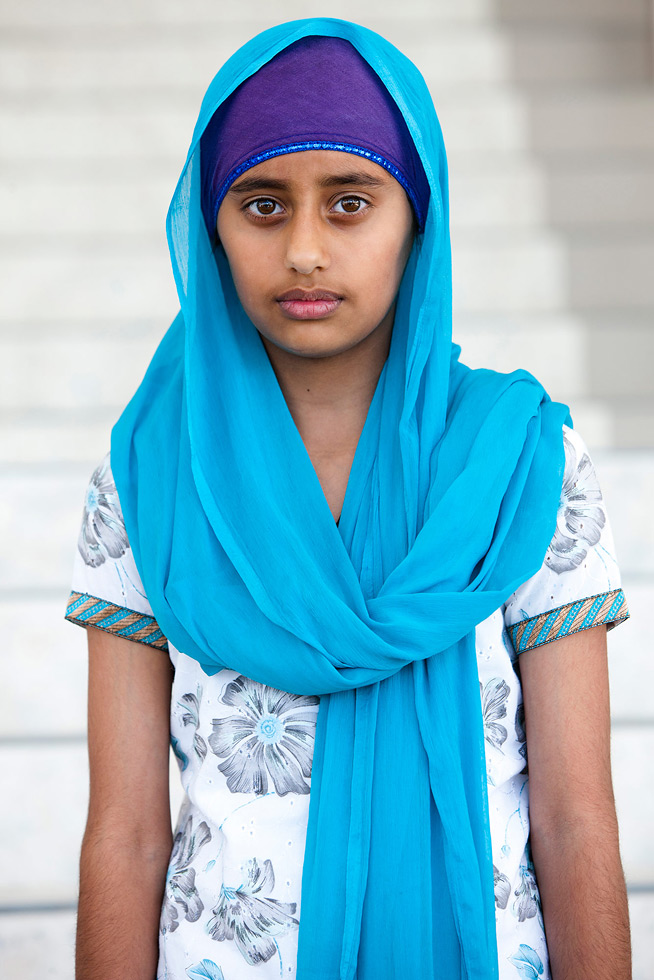How do you define your practice?
Photographer is the best description as I work with many different photographic disciplines.
Do you have a website or are you represented on a website?
louisewhelan.com.au and australiansall.photoshelter.com
How would you describe your relationship to the subject/s?
I met Kaloti Parmjit the day I took the photo. I first visited the Sikh temple in the suburb of Glenwood to take photos as part of a social documentary project I'm undertaking for the State Library of NSW. It is the documentation of the various ethnic communities living in NSW. This process of documenting intends to demonstrate the richness and diversity of ethnic communities in Australia. Australia is now one of the world's great multicultural countries with one in four Australians being born overseas. My images of both refugees and migrants now calling Australia home bear witness to our country's democratic values, by practicing traditions, religious choices, and languages within the law and free from discrimination. This photo was taken on one of my subsequent visits to the temple.
Was the photograph a result of a constructed, fabricated or candid encounter? Please describe.
Primarily this photograph was candid. I contacted the General Secretary of the Australian Sikh Association to request to photograph some of the youth who dress in traditional clothing to practice Gatk, a type of martial arts. Fifteen or so boys in practice and their siblings greeted me at the temple. Everyone was so keen to be photographed. Being familiar with the temple and its beautiful natural filtered light that flooded the leading stairs, I positioned myself there and the young boys and their siblings lined up for a portrait. Kaloti waited with patience as many were photographed before her, as her turn arrived she took her position, she had a quiet disposition not saying much. I asked her to look straight at the camera after a few shots Kaloti's friend approached her to reposition her scarf. I continued to photograph her honest almost uninhibited expression. I was grateful for her trust and honesty.
What are the ideas or themes underpinning your portrait?
This portrait is part of the work I am undertaking as a social documentary photographer for the State and National Libraries in Australia. This image is a representation of what Australia is today. My photos are a personal documentation of the ordinary aspects of everyday life in Australia; from migrants who may have been living here for 40 plus years to newly arrived refugee families. In relation to migration in Australia the images in this collection are a stark contrast to the recent mainstream fear-based media portrayal of boarder protection imagery. During my photographic journey there is much to witness in terms of cultural identity and assimilation. When working as a photographer it's important for me to honour the person I am photographing not just take something from them in terms of an image. I think people sense this and a trust is developed, without the trust there is no photograph. My work is driven by my inquisitiveness for other cultures, my need to expand myself by looking at how others live, what their beliefs are. Whilst documenting the various ethnic communities living in Australia, I have found myself in many different churches, mosques, temples, and cemeteries and have taken part in various spiritual rituals and religious ceremonies. More often than not the language is not of my own, from an address by the Dalai Lama to the Tibetan community of Australia to a Hmong New Year ritual, being unfamiliar with the cultural protocol of the various ethnicities; I work with a respect and natural reverence.
Please describe the technical aspects of your photograph?
This is a digital image shot on the Canon eos 1ds Mark III. The lens is a Canon 70-200mm the focal length for this shot was 125mm. ISO 250 exposure 1/250 at f3.5. I photographed with natural filtered light through a large window at about 9.30am on a cloudy day. There was minimal retouching, just a very slight sharpening.
How was the final print made? Is this print one of an edition?
I printed this work on Fuji Flex paper, which is an ultra-gloss. I choose it for maximum impact as some of the gloss effect can get lost behind the Perspex. The work was printed on a Lambda printer, which is ideal for skin tones. This print is the artist proof. There will be 12 prints in this edition.
Describe your consideration of scale, mounting and framing in the presentation of your portrait?
The size of the print was determined by the quality of the file. The print looked good and held together at a large scale. I printed with the intention of the final artwork including the frame to be around one metre in height. The image looks impressive at this scale. I like to keep my framing simple for these stronger portraits.
Who would you nominate as your influences?
My influences are broad being both visual and literary. I love the visual notion of poetry, with the likes of William Blake, D.H Lawrence, Emily Dickinson, Sylvia Plath and Walt Whitman. Film Directors, Luc Besson, Alfred Hitchcock, and Terrence Malick, photographers Walker Evans, Cecil Beaton, Max Dupain, Sebastiao Salgado, Henri Cartier-Bresson, Julia Margaret Cameron and Mary Ellen Mark.
Do you have any advice for young photographers (eg. students)?
Firstly learn all the rules and the technical aspects of your craft. Be a quiet observer, anticipate situations, understand light for light to a photographer is the equivalent to paint for a painter, and don't be afraid to ask. Immerse yourself into all aspects of photography; find your visual voice.














